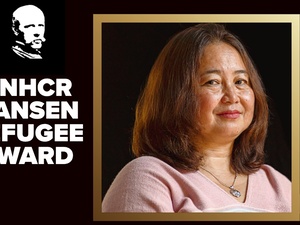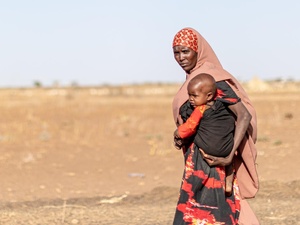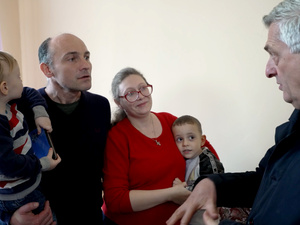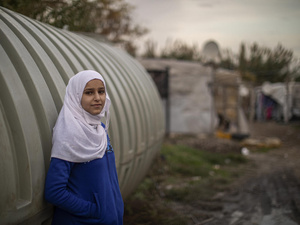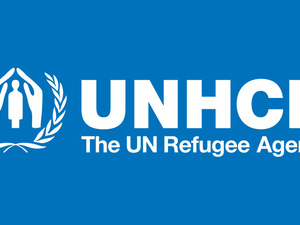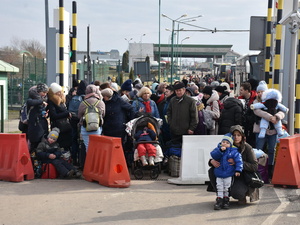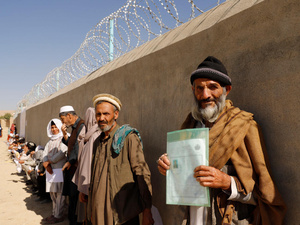Forced displacement hit record high in 2021 with too few able to go home
Forced displacement hit record high in 2021 with too few able to go home

Two internally displaced sisters from Jalalabad pictured in their temporary accommodation in Kabul, Afghanistan.
GENEVA – The number of people displaced by conflict, violence, persecution and human rights abuses rose for the tenth straight year in 2021 to reach the highest level since records began, according to the latest Global Trends report released today by UNHCR, the UN Refugee Agency.
"Either the international community comes together to take action to address this human tragedy, resolve conflicts and find lasting solutions, or this terrible trend will continue,” said United Nations High Commissioner for Refugees, Filippo Grandi.
Since the start of this year, the Russian invasion of Ukraine has pushed the number of forcibly displaced people worldwide to over 100 million. But according to the detailed data in the report, last year’s numbers were already at record levels.
- See also: UNHCR: Ukraine, other conflicts, push forcibly displaced total over 100 million for first time
At the end of 2021, the number of people forced to flee their homes reached 89.3 million, up 8 per cent over the year before and well over double the figure of 10 years ago. That figure included a record 27.1 million refugees and 53.2 million internally displaced people (those who fled their homes but remained inside their country). The number also included 4.4 million Venezuelans displaced abroad and 4.6 million asylum seekers.
Last year’s increase was fueled by new and existing emergencies, including events leading to the Taliban takeover of Afghanistan in August, which caused widespread displacement within the country and across borders. Conflict in the Tigray region of Ethiopia forced at least 2.5 million people to flee within the country, with some 1.5 million returning to their homes later in the year.
Violent insurgencies in the Central Sahel region of Africa sparked fresh internal displacement, particularly in Burkina Faso and Chad. In Myanmar, a military takeover in February 2021 caused violence that forced many to flee, while the number of Venezuelans displaced abroad grew by more than 500,000 last year.
Alemtsehay Hagos Gerezehr, 25, fled violence in northern Ethiopia to seek safety in South Sudan last year with her son, now aged two. Pregnant when she arrived, her two-month-old daughter was born in the camp where they now live. Alemtsehay struggles to support her family on food rations in South Sudan, which is facing its worst food crisis in a decade.
“I have a small shop here where I sell soap and coffee beans, but it’s not enough to survive,” she said, sitting in a dirt-floored shelter at Doro refugee camp in Maban County. “All I want is peace so that I can go home.”

Ethiopian refugee Alemtsehay Hagos Gerezehr, 25, with her baby daughter at Doro refugee camp, Maban County, South Sudan.
Returning home in safety and dignity is the preferred solution for most refugees. Barring that, options include integrating fully into the community to which they fled or being resettled to a third country. However, the speed and volume of displacement continues to outpace solutions for refugees.
Last year, nearly 430,000 refugees were able to return home, a 71 per cent increase over the previous year but still a tiny fraction of the total.
Of the estimated 1.4 million refugees in need of resettlement in 2021 – including children and adolescents, survivors of torture and violence, and older people – 57,500 were given homes in new countries. That was 67 per cent higher than in 2020, but still far below pre-pandemic levels and only 4 per cent of the total requiring resettlement.
Countries made some strides in integration in 2021, with an estimated 56,700 refugees from 161 different countries of origin naturalized in 23 host countries, which represented a return to pre-pandemic levels.
The number of internally displaced people (IDPs), who make up roughly 60 per cent of all those forced to flee their homes, also reached a record high last year, with Syria, Colombia, the Democratic Republic of the Congo, Yemen, Ethiopia and Afghanistan continuing to experience the highest levels of internal displacement.
In 2021, IDP returns increased to reach pre-pandemic levels, with an estimated 5.3 million people returning during the year. However, many countries – including the DRC, Cameroon, Iraq and South Sudan – saw a drop in the number of people able to go home.
Nzedha Ndrodza Alphosine, an internally displaced person in eastern DRC, fled her village in Ituri province with her family in 2019 when a militia attacked their home. Now living in a displacement camp in another part of Ituri, Nzedha worries she may never return to her village.
“Life is tough here. In my village, I had a farm with my husband. When we cultivated, we would get a lot of sacks of maize, and we would sell them. I was able to earn a living. I paid my children’s school fees and was able to give them whatever they needed. I can’t afford to pay fees now,” Nzedha said.
“I feel dejected. I don’t know what to do. There’s hunger and we have very little to eat here. I feel sad about my children.”
Writing by Sarah Schafer, with additional reporting by Tim Gaynor in South Sudan and Mary Wambui in DRC.
Correction: A graphic in an earlier version of the Global Trends video mistakenly said there were 89.3 million refugees at the end of 2021. An update corrects it to 89.3 million people forced to flee.



